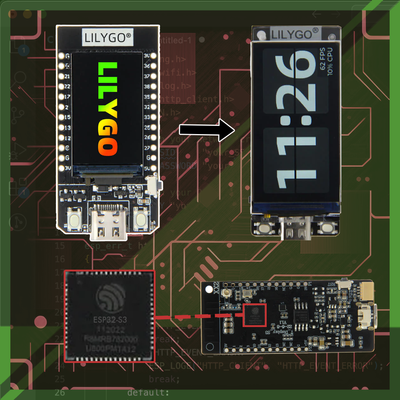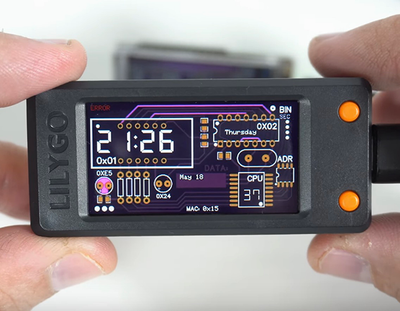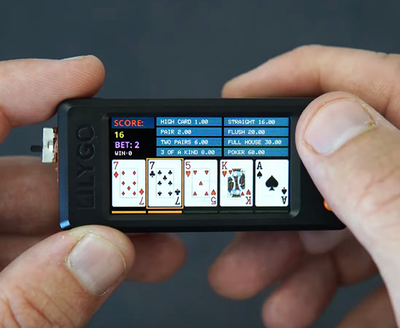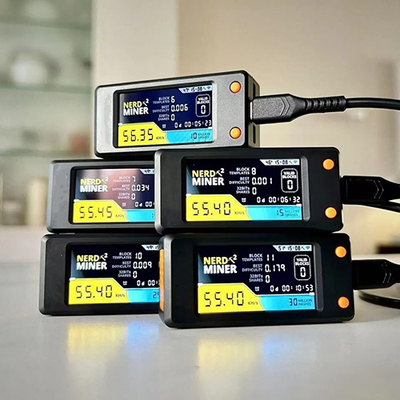
All Lilygo T-Display ESP32 Development Boards Difference
The list of all Lilygo TTGO T-Display Series development boards based on the ESP32. Pros, Cons, Differences, and a Guide to find the Best ESP32 with LCD
LILYGO® is a trademark of a company "Shenzhen Xinyuan Electronic Technology Co., Ltd", based in Shenzhen, China. Under this name, the company is producing open-source hardware and Internet of Things (IoT) devices sometimes also known as TTGO and based on ESP32 microcontrollers.
Lilygo is known for its wide range of different development boards, including the T-Display Series development boards, which we are going to talk about in this post. The Lilygo T-Display development boards are based on ESP32 and come with a screen built into the development board, where the name "Display" comes from.
The official Lilygo shop ships orders worldwide, but they ship them from China, which might take a long time and might incur additional fees. However, the Lilygo boards are becoming widely available in various DIY shops, as well as on Amazon and Aliexpress.
In this post, we are going to list all the Lilygo T-Display development boards and discuss their features, similarities and differences.
Our favorite Lilygo TTGO T-Display Series boards are:
T-Display-S3 #
Lilygo T-Display S3 Board
The Lilygo T-Display S3 is currently the most popular board from the variety of T-Display series. It is based on the ESP32-S3 chip and therefore provides WiFi, Bluetooth 5.2 and BLE connectivity, 16 MB of flash memory and 8MB PSRAM.
Prices are subject to change. Check current prices:
T-Display-S3 features a 1.9" Full-color TFT LCD Display with 170 x 320 px resolution. The screen is controlled by the ST7789 display controller driver chip with the SPI protocol.
The T Display S3 also comes with two built-in programmable buttons, that can be used to control the UI on the screen or for any other purpose.
We must also mention that it comes with a USB-C port and a built-in battery charger, where the battery can be connected using the included JST 1.25mm 2-Pin connector.
T-Display-S3 Case #
T-Display-S3 Case (Shell)
Optionally, you can choose the T Display-S3 with a case (or a shell, as they call it). The Lilygo offers two options - black or grey main color and orange accent in both. Additionally, you can buy the case separately, directly from Lilygo website.
Prices are subject to change. Check current prices:
T-Display S3 Touch #
T-Display-S3 Touch Board
The Lilygo T-Display-S3 Touch is the edition of the T-Display-S3 described above and, therefore comes with the same specifications. The only difference is that it comes with a Capacitive Touch Screen functionality.
Prices are subject to change. Check current prices:
T-Display-S3 AMOLED #
T-Display-S3 AMOLED Board
The Lilygo T-Display-S3 AMOLED is another edition of the already discussed T-Display-S3 series. As the name suggests, it comes with a 1.91" AMOLED Screen with a resolution of 240 x 536 pixels.
Prices are subject to change. Check current prices:
Another difference is that the screen is controlled by QSPI protocol, as opposed to the SPI of the previously discussed versions and is controlled by the RM67162 screen controller.
T-Display-S3 Long #
T-Display-S3 Long Board
One more version of the popular T-Display-S3 Series, the T Display S3 Long provides a wider screen of 3.4" and 180 x 640 pixels resolution.
Prices are subject to change. Check current prices:
T-Display-S3 Pro #
This board comes with a larger 2.33" screen, that has a resolution of 222 x 480 pixels, which is driven by the ST7796 screen controller chip with the SPI protocol. Additionally, on the top of the screen, there is an embedded ambient light and proximity sensors.
Another great upgrade from the previous version is the added expansion of the camera module through a POGO pin. You can also buy the version with a camera module included in the package.
To store the media from a camera module, or other heavier files of your application, the T-Display-S3 Pro board provides a slot for a microSD card.
One of the most prominent features of the Pro board is the addition of the SY6970 chip for Phone OTG (USB On-The-Go). The OTG is a standard that allows devices like smartphones or in this case, the ESP32, to act as a host and connect to other USB devices, such as USB flash drives, keyboards, mice, and more.
Finally, the T Display S3 Pro has an internal MPU9250 IMU or Inertial Measurement Unit, module, that includes an accelerometer, gyroscope and magnetometer (compass) modules.
With the wide range of new features, this development board surely earned the Pro name.
Older Boards #
All the boards we have discussed so far are the new versions of previously released development boards in the T-Display series. While the newer boards (S3 versions) are more powerful, and provide better screens and more features, they probably make older versions cheaper. Also, to have some context on how the boards have developed over time, let's take a look at the older options as well.
T-Display #
Lilygo T-Display, also known as TTGO T-Display is the original and most known board in the T-Display series. Even though the T-Display-S3 makes this a bit outdated, it means the price of the board goes down and it already did.
Original T-Display Board
This board comes with a less powerful ESP32 chip, that has WiFi, Bluetooth 4.2 and BLE connectivity options. It has a smaller TFT LCD screen with a size of 1.14" and a resolution of 135 x 240 pixels. The screen is driven by an ST7789 screen controller chip.
Prices are subject to change. Check current prices:
T-Display Keyboard #
Lilygo TTGO T-Display Keyboard board
T-Display Keyboard board is the expansion for the original T-Display. It comes with a pin header, where you can plug or unplug your original T-Display board.
Prices are subject to change. Check current prices:
Lilygo sells these expansion boards in several packages, depending on what you might already have:
- Keyboard + T-Display Board
- Keyboard + Case + T-Display Board
- Only Keyboard
And of course, you can buy the T-Display board separately.
T-Display AMOLED Lite #
T-Display AMOLED Lite Board
T-Display AMOLED Lite is the first board that is based on the ESP32-S3 chip. It comes with a 1.47" IPS AMOLED screen, that has 194 x 368 pixels and provides a full viewing angle. The display is controlled by the RM67162 display control driver.
Prices are subject to change. Check current prices:
Comparison #
Ok, now all of this might be a little bit difficult to compare. But worry not, below you can find the comparison table of main differences of Lilygo TTGO T-Display series boards.
| Board | Chip | Screen Size | Resolution | Screen Type | Screen Driver |
|---|---|---|---|---|---|
| T-Display-S3 | ESP32-S3 | 1.9" | 170 x 320 | TFT | ST7789 |
| T-Display-S3 Touch | ESP32-S3 | 1.9" | 170 x 320 | Touch | ST7789 |
| T-Display-S3 AMOLED | ESP32-S3 | 1.91" | 240 x 536 | AMOLED | RM67162 |
| T-Display-S3 Long | ESP32-S3 | 3.4" | 180 x 640 | TFT | ? |
| T-Display-S3 Pro | ESP32-S3 | 2.33" | 222 x 480 | Touch | ST7796 |
| T-Display AMOLED Lite | ESP-32-S3 | 1.47" | 194 x 368 | AMOLED | RM67162 |
| T-Display | ESP32 | 1.14" | 135 x 240 | TFT | ST7789 |
| T-Display Keyboard | ESP32 | 1.14" | 135 x 240 | TFT | ST7789 |
The main things to notice in the table are:
- Chip - where we have two options - the older, original ESP32 or the newer ESP32-S3.
- Screen size and Resolution - screen sizes differ from 1.14" on the original T-Display board, to 3.4" on the T-Display-S3 Long wide display.
- Screen Type - Choices between TFT, AMOLED and Touch-screen.
- Screen Driver - Different screens are controlled by different screen drivers, which might be a concern for more advanced users.
Some projects with T-Display boards #
We love the Lilygo TTGO T-Display boards, because of the open-source hardware, and especially the software, where the creators of the board and community have created plenty of amazing projects you can try by yourself.
Lilygo repository and other examples #
Since the Lilygo boards are open-source, you can find the source code with examples for each board in the official profile of Lilygo - Xinyuan-LilyGO.
The VolosR YouTube channel "Volos Projects" has many more amazing projects and tutorials based on the T-Display-S3 boards, so make sure to check it out.
Nerdminer #
You can buy a variety of Nerdminers on the official store, but you can easily make it yourself with the T-Display-S3 board, or any other compatible board, which includes, but is not limited to:
- LILYGO T-Display 1.14
- LILYGO T-Display S3 AMOLED
- ESP32-WROOM-32
- ESP32-CAM
- M5-StampS3
- And more...
Conclusion #
When it comes to the ESP32 development boards with in-build displays, we love the Lilygo TTGO T-Display Series displays. The Lilygo offers a range of different boards with display, from the original T-Display to T-Display-S3, to the newer T-Display-S3-Pro.
While all of the boards offer similar functionalities, to choose the perfect board for your next project, you must consider the needs of your project, such as the screen size, touch-screen functionality, in-built sensors and more.
We hope this guide will help you make up your mind on your next ESP32 development board.










